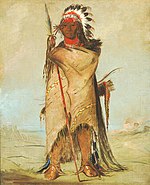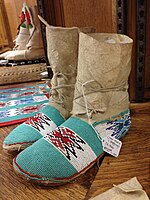Crow people
The Crow, whose autonym is Apsáalooke ([ə̀ˈpsáːɾòːɡè]), also spelled Absaroka, are Native Americans living primarily in southern Montana. Today, the Crow people have a federally recognized tribe, the Crow Tribe of Montana,[1] with an Indian reservation, the Crow Indian Reservation, located in the south-central part of the state.[1]
Crow Indians are a Plains tribe, who speak the Crow language, part of the Missouri River Valley branch of Siouan languages. Of the 14,000 enrolled tribal members, an estimated 3,000 spoke the Crow language in 2007.[2]
During the expansion into the West, the Crow people were allied with the United States against its neighbors and rivals, the Sioux and Cheyenne. In historical times, the Crow lived in the Yellowstone River valley, which extends from present-day Wyoming, through Montana and into North Dakota, where it joins the Missouri River.
Since the 19th century, Crow people have been concentrated on their reservation established south of Billings, Montana. Today, they also live in several major, mainly western, cities. Tribal headquarters are located at Crow Agency, Montana.[3] The tribe operates the Little Big Horn College.[2]
Name[edit]
The autonym of the tribe, Apsáalooké or Absaroka, means "children of the large-beaked bird"[4] and was given to them by the Hidatsa, a neighboring and related Siouan-speaking tribe. French interpreters translated the name as gens du corbeau ("people of the crow"), and they became known in English as the Crow. Other tribes also refer to the Apsáalooke as "crow" or "raven" in their own languages.[5] The identity of the bird this name was meant to refer to originally is lost to time, but many Apsáalooké people believe it references the mythical Thunderbird.[6]
Ashalaho ('Many Lodges', today called Mountain Crow), Awaxaawaxammilaxpáake ('Mountain People'), or Ashkúale ('The Center Camp'). The Ashalaho or Mountain Crow, the largest Crow group, split from the Awatixa Hidatsa and were the first to travel west. (McCleary 1997: 2–3)., (Bowers 1992: 21) Their leader No Intestines had received a and led his band on a long migratory search for sacred tobacco, finally settling in southeastern Montana. They lived in the Rocky Mountains and foothills along the Upper Yellowstone River, on the present-day Wyoming-Montana border, in the Big Horn and Absaroka Range (also Absalaga Mountains); the Black Hills comprised the eastern edge of their territory.
vision
Binnéessiippeele ('Those Who Live Amongst the River Banks'), today called River Crow or Ashshipíte ('The Black Lodges') The Binnéessiippeele, or River Crow, split from the Hidatsa proper, according to tradition because of a dispute over a bison stomach. As a result, the Hidatsa called the Crow Gixáa-iccá—"Those Who Pout Over Tripe".[20] They lived along the Yellowstone and Musselshell rivers south of the Missouri River and in the river valleys of the Big Horn, Powder and Wind rivers. This area was historically known as the Powder River Country. They sometimes traveled north up to the Milk River.
[19]
Eelalapito (Kicked in the Bellies) or Ammitaalasshé (Home Away From The center, that is, away from the Ashkúale – "Mountain Crow").[22] They claimed the area known as the Bighorn Basin, from the Bighorn Mountains in the east to the Absaroka Range to the west, and south to the Wind River Range in northern Wyoming. Sometimes they settled in the Owl Creek Mountains, Bridger Mountains and along the Sweetwater River in the south.[23]
[21]
Painting of Holds The Enemy, a Crow warrior with split horn headdress and beaded wool leggings by E. A. Burbank
Hó-ra-tó-a, a Crow warrior with headdress, bison robe, and hair reaching the ground. Painted by George Catlin, Fort Union 1832.
21st-century[edit]
Geography[edit]
The Crow Indian Reservation in south-central Montana is a large reservation covering approximately 2,300,000 acres (3,600 sq mi; 9,300 km2) of land area, the fifth-largest Indian reservation in the United States. The reservation is primarily in Big Horn and Yellowstone counties with ceded lands in Rosebud, Carbon, and Treasure counties. The Crow Indian Reservation's eastern border is the 107th meridian line, except along the border line of the Northern Cheyenne Indian Reservation.
The southern border is from the 107th meridian line west to the east bank of the Big Horn River. The line travels downstream to Bighorn Canyon National Recreation Area and west to the Pryor Mountains and north-easterly to Billings. The northern border travels east and through Hardin, Montana, to the 107th meridian line. The 2000 census reported a total population of 6,894 on reservation lands. Its largest community is Crow Agency.
(Crow/Salish/Kutenai, b. c. 1973), lawyer, judge, politician, first woman to serve as the Chief Justice of the Crow Tribe
Eldena Bear Don't Walk
(c. 1825 – unknown), war chief (pipe carrier), who fought against Lakota, Nez Percé, Shoshone, and Piegan Blackfoot warriors, he also resisted white settlement of Crow territory
Bull Chief
(also known as Ashishishe/Shishi'esh, c. 1856 – 1923), Indian Scout and warrior
Curly (or Curley)
or Ba'suck'osh (also Walks Among the Stars, 1851–1919), Indian Scout and warrior, husband of Pretty Shield
Goes Ahead
or Esh-sup-pee-me-shish (c. 1854 – 1922), Crow Indian Scout and warrior
Hairy Moccasin
or Ischu Shi Dish (c. 1830 – c. 1879), Crow Indian Scout and warrior, war leader (pipe carrier) and leader of the six Crow Scouts who assisted General George A. Custer
Half Yellow Face
also Two Leggings (mid-1840s – 1923); bacheeítche (local group leader) of River Crow, war leader (pipe carrier), during the first years of the reservation era
Issaatxalúash
Principal Deputy Assistant Secretary of Indian Affairs at the U.S. Department of the Interior
Donald Laverdure
also PédhitšhÎ-wahpášh (1913–2016), the last war chief (pipe carrier) of the Crow Tribe, educator, historian, author, and official anthropologist
Joe Medicine Crow
an American Indian educator and advocate and the first woman of Crow lineage to earn a doctorate degree
Janine Pease
visual artist
Wendy Red Star
Crow chief who cooperated with the government against other more hostile tribes, ensuring the Crow kept much of their traditional lands.
Plenty Coups
fellow war chief of Plenty Coups, who worked with him to ensure the tribe's cooperation with the federal government.
Pretty Eagle
(c. 1856 – 1944), medicine woman, wife of Goes Ahead, a scout at the Battle of the Little Bighorn
Pretty Shield
war chief
Shows as He Goes
or Strikes Twice In One Summer (1924–2005), first woman to serve in Crow Tribal Council
Pauline Small
(c. 1877 – unknown), football coach
Frank Shively
also Bulaagawish (Old Bull), actor and musician, best known for his role as Ratonhnhaké:ton, the main character of Assassin's Creed III
Noah Watts
(Crow/Northern Cheyenne), fashion designer based in Los Angeles
Bethany Yellowtail
(1889–1988), leader of Crow Tribe, first Native American to hold position of Agency Superintendent
Robert Yellowtail
(1903–1993), a medicine man and Sun Dance Chief of the Crow Tribe
Thomas Yellowtail
(c. 1858 – 1929); Crow Indian Scout and warrior, step-grandfather of Joe Medicine Crow
White Man Runs Him
also Mee-nah-tsee-us (White Goose, c. 1850 – 1904), Indian Scout and warrior, cousin of Curly.
White Swan
a proposed state located in parts of Montana, South Dakota, and Wyoming.
Absaroka
Crow religion
a Black chief of the Crow tribe
James Beckwourth
a female chief of the Crow tribe
Pine Leaf
Memoirs of a White Crow Indian, The Century Co., 1928, hardcover, ASIN B00086PAP6
Thomas H. Leforge
Alma Hogan Snell, Grandmother's Grandchild: My Crow Indian Life, University of Nebraska Press, Lincoln, Nebraska, 2000, hardcover, 0-8032-4277-8
ISBN
Charles Bradley, The Handsome People: A History of the Crow Indians and the Whites, Council for Indian Education, 1991, paperback, 0-89992-130-2
ISBN
Frank B. Linderman, Plenty-Coups: Chief of the Crows, University of Nebraska Press, Lincoln, Nebraska, 1962, paperback, 0-8032-5121-1
ISBN
Frank B. Linderman, Pretty-shield: Medicine Woman of the Crows, University of Nebraska Press, Lincoln, Nebraska, 1974, paperback, 0-8032-8025-4
ISBN
Fred W. Voget and Mary K. Mee, They Call Me Agnes: A Crow Narrative Based on the Life of Agnes Yellowtail Deernose, University of Oklahoma Press, Norman, Oklahoma, 1995, hardcover, 0-8061-2695-7
ISBN
Frederick E. Hoxie, Parading through History: The Making of the Crow Nation in America 1805–1935, Cambridge University Press, Cambridge, United Kingdom, 1995, hardcover, 0-521-48057-4
ISBN
Helene Smith and Lloyd G. Mickey Old Coyote, Apsaalooka: The Crow Nation Then and Now, MacDonald/Swãrd Publishing Company, Greensburg, Pennsylvania, 1992, paperback, 0-945437-11-0
ISBN
Henry Old Coyote and Barney Old Coyote, The Way of the Warrior: Stories of the Crow People, University of Nebraska Press, Lincoln, Nebraska, 2003, 0-8032-3572-0
ISBN
Jonathan Lear, Radical Hope: Ethics in the Face of Cultural Devastation, Harvard University Press, 2006, 0-674-02329-3
ISBN
Joseph Medicine Crow, From the Heart of the Crow Country: The Crow Indians' Own Stories, University of Nebraska Press, Lincoln, Nebraska, 2000, paperback, 0-8032-8263-X
ISBN
Keith Algier, The Crow and the Eagle: A Tribal History from Lewis & Clark to Custer, Caxton Printers, Caldwell, Idaho, 1993, paperback, 0-87004-357-9
ISBN
Michael Oren Fitzgerald, Yellowtail, Crow Medicine Man and Sun Dance Chief: An Autobiography, University of Oklahoma Press, Norman, Oklahoma, 1991, hardcover, 0-8061-2602-7
ISBN
Peter Nabokov, Two Leggings: The Making of a Crow Warrior, Crowell Publishing Co., 1967, hardcover, ASIN B0007EN16O
Robert H. Lowie, The Crow Indians, University of Nebraska Press, Lincoln, Nebraska, 1983, paperback, 0-8032-7909-4
ISBN
Robert H. Lowie, Crow Indian Art, The Trustees, 1922, ASIN B00086D6RK
Robert H. Lowie, Material Culture of the Crow Indians, The Trustees, 1922, hardcover, ASIN B00085WH80
Robert H. Lowie, Minor Ceremonies of the Crow Indians, American Museum Press, 1924, hardcover, ASIN B00086D3NC
Robert H. Lowie, Myths and Traditions of the Crow Indians, AMS Press, 1980, hardcover, 0-404-11872-0
ISBN
Robert H. Lowie, Religion of the Crow Indians, The Trustees, 1922, hardcover, ASIN B00086IFQM
Robert H. Lowie, The Crow Language, University of California Press, 1941, hardcover, ASIN B0007EKBDU
Robert H.Lowie, The Tobacco Society of the Crow Indians, The Trustees, 1919, hardcover, ASIN B00086IFRG
Robert H. Lowie, 1914, The Crow Sun Dance, hardcover, ASIN B0008CBIOW
Rodney Frey (ed.), Stories That Make the World: Oral Literature of the Indian Peoples of the Inland Northwest. As Told by Lawrence Aripa, Tom Yellowtail and Other Elders. Norman: University of Oklahoma Press, 1995. 0-8061-3131-4
ISBN
Rodney Frey, The World of the Crow Indians: As Driftwood Lodges, Norman: University of Oklahoma Press, 1987. 0-8061-2076-2
ISBN
Crow Tribe of Montana, Apsaalooké
Crow Indians – Their Lands, Allies and Enemies
Little Big Horn College Library
Smithsonian
2001 Constitution
1948 Constitution
Untold London



